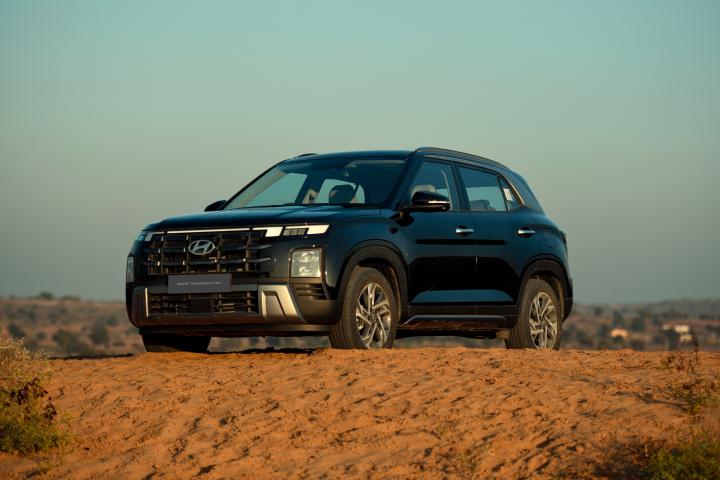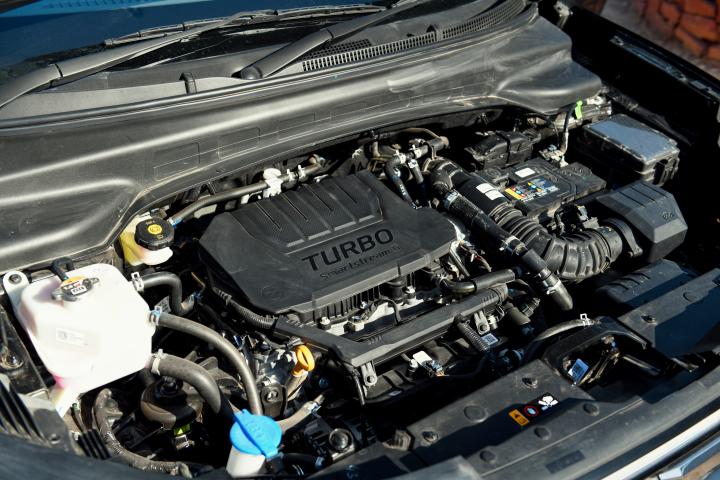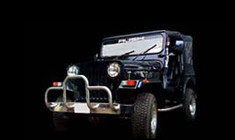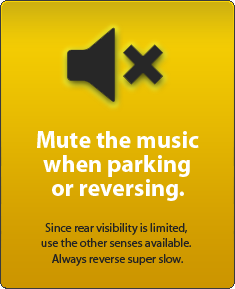News
Hyundai Creta Facelift : Our observations after a day of driving
Get on some open roads and you can let the Creta stretch its legs. Put your right foot down and before you know it, you’ll hit the highway speed limit of 120 km/h.
Driving the Hyundai Creta 1.5L Turbo-Petrol DCT Automatic
The 138 BHP, 1.4L Kappa turbo-petrol engine mated to the 7-speed DCT in the outgoing model was quite powerful and quick. However, the engine had to be upgraded to meet the prevailing emission norms. The result is this Smartstream 1.5L turbo-petrol engine which still belongs to the Kappa family and makes an impressive 158 BHP and 253 Nm and is shared with the new Hyundai Verna and the Kia Seltos facelift. The Hyundai-Kia siblings have the best performance figures in the segment. The 1.5L turbo-petrol engine is only available with a 7-speed DCT automatic and doesn't get the 6-speed iMT that the Seltos gets.
Fire up the engine, and it's refined at idle, silently purring away. Hyundai-Kia powertrains have always set NVH benchmarks, and this car is no different. Shift to D or R, and it crawls away smoothly. Crawling at city speeds isn’t very dramatic and the 1.5L is very well-behaved. With light to medium throttle inputs, you can go about your daily commute quite comfortably. In comparison with the old 1.4L turbo-petrol, the throttle response is smoother and power delivery is more linear. The 7-speed dual-clutch transmission is also seamless moving through the initial gears. However, we did notice that the gearbox got a little confused on a few instances while driving through some traffic. There was also an instance where the gearbox upshifted on its own when coming down a slope without any throttle input. This was strange as we'd have expected it to hold the gear. Start driving and you will appreciate the healthy low-end of this engine. Thanks to the turbocharger and direct injection, you’re never at a shortage of power. Just floor the accelerator if you want to close a gap in traffic or make that quick overtake and the engine and gearbox will do the rest.
Get on some open roads and you can let the Creta stretch its legs. Put your right foot down and before you know it, you’ll hit the highway speed limit of 120 km/h. This is the thing with turbo-petrol engines - flooring the throttle on an empty stretch of road can get addictive. Outright acceleration is great and it feels a little more linear as well compared to say, the 1.5 TSI from the VW-Skoda cars. The turbo delivers a strong mid-range punch that will take care of all the overtaking on the highway. You can cruise along the highway at 100 km/h while the engine spins at a relaxed 1,800 rpm. Even at 120 km/h, the engine felt relaxed with the rev counter reading 2,200 rpm. The Creta won't break a sweat cruising at these speeds all day long.
The dual-clutch transmission moves through the gears seamlessly. The kickdown response time is quick enough and the gearbox doesn’t hesitate to drop down 3 or even 4 gears at times to get the engine into the powerband. When you are in the mood for some fun in the ghats, switch to Sport mode and start flipping the paddle shifters for manual control. The ECU matches the revs which is always very satisfying. In comparison to the Kia Seltos, the Creta doesn't sound very happy at high revs. And while the overall NVH package is good, the engine doesn't sound very sporty at high revs. Hyundai has restricted the maximum rpm to 5,900, which is too low, and the engine sounds a bit strained at this rpm. The paddle shifters are responsive, and you can extract some performance from the engine using them for quick overtakes or keeping the engine in the powerband on some twisties. What's different from the Hyundai Verna and the Kia Seltos facelift is that the gearbox gets an "S" mode in the Creta. You can engage it by sliding the gear lever to the right (when in D) and this makes the gearbox hold on to the gears a bit longer. You'll appreciate the gearbox "S" mode when pushing the car on some twisty roads. You can also take control of the gears using the paddle shifters and manually keep the engine in the power band. While this adds a bit of control, the gearbox logic in the Taigun and Kushaq 1.5 DSG is better and more in tune with the requirements of the driver.
The Creta gets 3 drive modes - Eco, Normal and Sport.
Eco Mode - Engage the Eco mode when you want to extract maximum fuel efficiency. The throttle response is dulled, but given the power on tap, the mode is quite comfortable to use in the city. In fact, we preferred driving in this mode in the city as the car becomes a lot smoother to drive. The Auto Start-Stop feature is activated automatically when you select the Eco mode. Also, while driving in the city in Eco mode, we noticed that the gearbox wasn't downshifting easily when the accelerator was pressed. It wanted to stay in the higher gears to extract more fuel efficiency.
Normal Mode - This is the default mode and just as the name suggests, it's normal to drive. There is a noticeable difference between Normal and Eco mode. This mode can be used for day-to-day driving which has a mix of city and open roads.
Sport Mode - Engage this mode when you want the car to be more responsive to your inputs. The throttle response is sharper, and the transmission also holds on to gears a bit longer in this mode. The steering is also noticeably heavier, although not as much as enthusiasts would like (more on this later). Sport mode isn't something you'd want to engage in the city as it can get a bit jerky to drive.
Noise, Vibration & Harshness (NVH)
The 1.5-litre unit is very refined overall. At city speeds as well as while cruising at 100 km/h, you can barely hear the engine in the cabin. Even the vibrations are well controlled and cruising with the family on the highway should be comfortable.
Tyre noise does creep into the cabin at highway speeds, but the wind noise is kept well in check. Insulation in the wheel well is also pretty good as you don't hear a lot of the pebbles when driving over some loose gravel.
Mileage & Fuel economy
The Creta comes equipped with an Auto Start-Stop feature that helps fuel efficiency in city driving conditions. The ARAI-certified fuel efficiency for the 1.5-litre turbo-petrol DCT is 18.4 km/l which is a little bit more than that of the Seltos (17.9 km/l). Of course, the real-world FE numbers will be much lower considering that turbo-petrol DCTs are very sensitive to the driving style. We’ll wait for some ownership reviews to get a better picture of real-world fuel efficiency. Fuel tank capacity remains the same at 50 litres and the new Creta is E20 compatible.
1.5L, 4-cylinder turbo-petrol engine makes 158 BHP @ 5,500 rpm and 253 Nm @ 1,500-3,500 rpm:

The 1.5L turbo-petrol engine is offered only with a 7-speed DCT and in single top-end SX(O) variant:

Suspension

Ride Comfort
The Creta gets a McPherson strut suspension at the front and a torsion beam axle at the rear. The setup is similar to the Kia Seltos, but the tuning is different for both cars. Also, the Seltos is offered with 18-inch wheels on the top-spec trim while the Creta has capped the wheel size at 17 inches. The E, EX and S variants get 16-inch wheels with 205/65 section tyres, while the S(O), SX, SX Tech and SX(O) variants get 17-inch wheels with 215/60 section tyres.
Once again, drawing a comparison with the Seltos, the Creta's ride quality is more comfortable. There’s still an underlying stiffness to the ride quality, but overall the setup is very much what you would expect from a Hyundai. At slow speeds, small bumps and potholes are absorbed well. The suspension works silently in absorbing small potholes and there is a cushioning effect. There’s still some amount of body movement felt inside the cabin over bad roads, but it’s manageable. And while the suspension feels comfortable, it doesn't feel as abuse-friendly as something like a Tata Harrier.
Handling & Dynamics
The Hyundai Creta has an inherently mature suspension setup. It behaves nicely at high speed and there is no bounciness or that feeling of floatiness. The car is well-planted with satisfactory high-speed stability. While doing triple-digit speeds on the open road, the Creta displayed good composure. Recovery from expressway undulations is also surprisingly good for a Korean car. Expansion joints of the city flyovers were also absorbed nicely when at speed.
In the area of dynamics, the Creta remains a clean & predictable handler. Through fast corners, the car remains sorted and there are no unnerving surprises. Of course, due to its height, some body roll is present, but it is well-controlled and one can push it through corners confidently. Good to know that all variants are equipped with ESP which can be a lifesaver in emergencies. Our test car was shod with JK UX Royale tyres whose grip levels were average. BHPians looking to extract some performance might want to upgrade to richer Michelin or Yokohama rubber.
Steering
The Creta gets a well-tuned EPS. It is light & smooth in the city. As the speedometer climbs, the EPS feels reasonably direct and fast too. The fair all-round visibility, smooth gearboxes (automatics in particular) and light controls make this crossover easy to drive in urban conditions. On the highway, the steering feels stable and has no nervousness. However, there is a bit of extra play in the centre at speed and then you suddenly feel the weight when you start turning. We'd have liked a bit more consistent feedback as it provides that additional confidence while entering into a corner.
Braking
Hyundai has made all-wheel disc brakes standard across all variants. Additionally, you also get brake assist and ABS. While braking from high speeds, the car stops in a straight line without any drama. No complaints in the braking area. The brake pedal felt extremely sharp to the inputs and you have to be very gentle with the application to decelerate smoothly. This takes some time to get used to.
Niggles & Problems
The standard warranty of the Creta is 3 years/unlimited km which can be extended up to 7 years (only for petrol variants). You also get 3 years of roadside assistance. There are also 5 years of running repair and maintenance packages that you can opt for.
While most of the recent feedback about this 1.5-litre turbo-petrol has been positive, the turbo-petrol engine with the dual-clutch transmission is something you should be careful with. Early owners of the Creta & Seltos 1.4 turbo-petrol DCT did face some gearbox overheating issues. While most of them have been resolved, it’s very much advisable to go for the maximum extended warranty. Don’t even think about it twice. It’s better to be safe than sorry.
Continue reading the discussion on the Hyundai Creta Facelift on our forum.
























